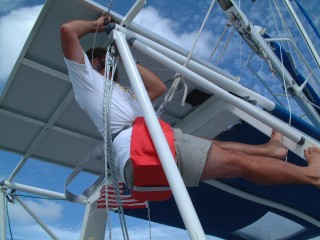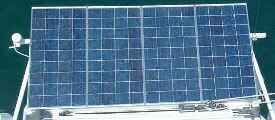

One of the first things we realized when we got on board Ocelot is that her batteries were flat. There wasn't enough power to make the readouts work. We couldn't run the engines because we were out on the hard and the engines need salt water for their cooling systems. Even if we had been in the water, the starter batteries were flat too! We were able to recharge one starter battery from shore power, but the other one was the wrong type, and poorly connected as well! The house batteries, four 4-D gel-cells, simply wouldn't hold much charge. At least one of them may well have been a six-year-old original. When we took it out of the loop, the batteries worked slightly better, but we still needed more capacity.
 We had anticipated needing solar panels,
since we didn't want to run the engine(s) every day. We had measured the area
where we wanted to mount the panels so that we knew how much space we had, and
we started researching different panels back at the house. We decided on four
Kyocera© 120-watt panels. They produced the greatest power per
panel, and had the best power to cost ratio. They also fit quite nicely on our
targa bar. We bought four of them and had them shipped down to St. Martin/St.
Maarten (SXM). Unfortunately, one of the panels was shattered during shipping, but we
got the other three up. Each one produces between 30 and 40 amp-hours per day, at
battery charging voltage of about 14 volts. (See my Energy
Budget.)
We had anticipated needing solar panels,
since we didn't want to run the engine(s) every day. We had measured the area
where we wanted to mount the panels so that we knew how much space we had, and
we started researching different panels back at the house. We decided on four
Kyocera© 120-watt panels. They produced the greatest power per
panel, and had the best power to cost ratio. They also fit quite nicely on our
targa bar. We bought four of them and had them shipped down to St. Martin/St.
Maarten (SXM). Unfortunately, one of the panels was shattered during shipping, but we
got the other three up. Each one produces between 30 and 40 amp-hours per day, at
battery charging voltage of about 14 volts. (See my Energy
Budget.)
 The solar panels produced lots of power, but even
so we had to run the engines twice a day (we were in the water by now) because the batteries
wouldn't hold much charge from the panels. Since the panels only produce while
the sun was actually in the sky, and since our battery capacity was too low to
last us through the night, we ran the engines in the mornings and evenings. We decided we had to replace the batteries. We
got a good deal on three new 8-D gel-cells, which held about the same amount of
power as four new 4-Ds. We also replaced the starboard engine starter battery,
which wasn't the same kind as our other batteries, with a new gel-cell so it matched the port
starting battery.
The solar panels produced lots of power, but even
so we had to run the engines twice a day (we were in the water by now) because the batteries
wouldn't hold much charge from the panels. Since the panels only produce while
the sun was actually in the sky, and since our battery capacity was too low to
last us through the night, we ran the engines in the mornings and evenings. We decided we had to replace the batteries. We
got a good deal on three new 8-D gel-cells, which held about the same amount of
power as four new 4-Ds. We also replaced the starboard engine starter battery,
which wasn't the same kind as our other batteries, with a new gel-cell so it matched the port
starting battery.
 The solar panels (we have all four up now) produce so much
power that they would overcharge and destroy the batteries if we let them. To
prevent this, we put a charge controller between the batteries and the panels.
The controller does several things. First, it monitors the incoming power and
regulates it so it won't damage the batteries. It also needs to monitor the
battery voltage to do this, and can also display the voltage (an indicator
of battery status) to us at any point. Second, the controller prevents the
batteries from discharging through the panels at night and connects them
automatically whenever there is power coming from the panels. Third, the controller will
actually convert the 17 volts from the panels to about 14 for charging the
batteries. Normally, those other three volts are wasted. However, they represent
over 20 watts. This controller uses a DC to DC voltage conversion to give us
back at least some of that power.
The solar panels (we have all four up now) produce so much
power that they would overcharge and destroy the batteries if we let them. To
prevent this, we put a charge controller between the batteries and the panels.
The controller does several things. First, it monitors the incoming power and
regulates it so it won't damage the batteries. It also needs to monitor the
battery voltage to do this, and can also display the voltage (an indicator
of battery status) to us at any point. Second, the controller prevents the
batteries from discharging through the panels at night and connects them
automatically whenever there is power coming from the panels. Third, the controller will
actually convert the 17 volts from the panels to about 14 for charging the
batteries. Normally, those other three volts are wasted. However, they represent
over 20 watts. This controller uses a DC to DC voltage conversion to give us
back at least some of that power.
All of this is very useful for DC applications, but what about AC? The boat actually came with considerably more AC outlets then DC. Despite this, the boat came with no generator and no inverter, so any AC power had to come from shore. The boat did have a 230V AC-to-14V DC battery charger, but nothing to turn DC to AC, and no 115 volt circuitry. We took out the old charger and replaced it with an inverter/charger that generates 115 volts AC at up to 1,500 watts, or charges the batteries from 115V AC using shore power or a generator. The inverter doesn't produce a perfect sine wave, but it's close enough for most equipment and much more efficient than a true sine-wave unit. The only problem with this big inverter is that it wastes some power. My grandfather, seeing that we needed an alternate way to power the computers, gave us a smaller inverter which is much more efficient, but can only provide a tenth as much output. However, this is sufficient to run two of our computers simultaneously, and we have a more powerful (though still small) inverter that can produce more if we need it to.
On the other hand, the little inverters still aren't extremely efficient, and they also produce a lot of electrical noise (RF, or radio frequency radiation, which comes over our SSB as static.) While we don't use the SSB and computer together for talking to people, when we get e-mail or weather faxes, we needed to use the laptop's batteries. We had bought some DC to DC voltage converters back in the US, but they wouldn't support the computers. Later, we got another converter which provided enough power, but still made lots of noise. Then, we got yet another converter, this one specially designed to produce no RF. This one, made by a HAM operator (N4UAU) for use with SSB radios, is very efficient as well, and we use it all the time.
Top Level: Home | Destinations | Cruising Info | Underwater | Boat Guests | Ocelot | Sue | Jon | Amanda | Chris | Site Map | Make a Comment
![]()
|
If our information is useful, you can help by making a donation |
Copyright © 2000‑ Contact: Jon and Sue Hacking -- HackingFamily.com, svOcelot.com. All rights reserved.